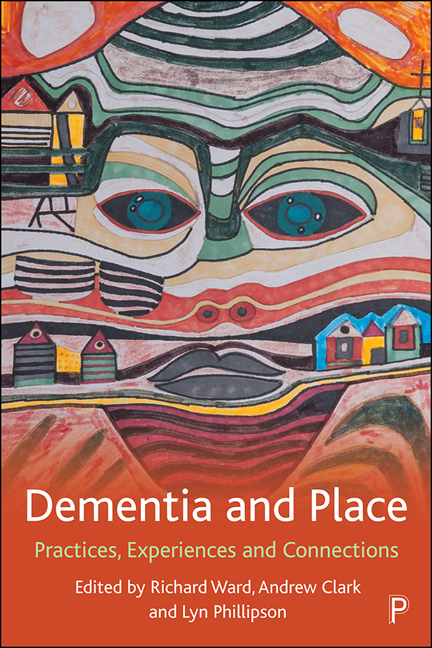Book contents
- Frontmatter
- Dedication
- Contents
- List of figures and tables
- Notes on contributors
- Acknowledgements
- 1 Introduction: Placing dementia
- 2 Understanding the meaning of neighbourhoods for people living with dementia: the value of a relational lens
- 3 Moving house with dementia
- 4 How do people with dementia manage problematic situations in public spaces?
- 5 Making and maintaining neighbourhood connections when living alone with dementia
- 6 My neighbourhood, my future ...?
- 7 Enabling the neighbourhood: a case for rethinking dementia-friendly communities
- 8 A conceptual framework of the person– environment interaction in the neighbourhood among persons living with dementia: a focus on out-of-home mobility
- 9 We’re known as ‘the girls’ around town: support, isolation and belonging for a lesbian couple living with dementia
- 10 Building community capacity for dementia in Canada: new directions in new places
- 11 The good, the challenging and the supportive: mapping life with dementia in the community
- 12 Growing back into community: changes through life with dementia
- 13 Dementia, tourism and leisure: making the visitor economy dementia friendly
- 14 Conclusion: Dementia emplaced
- Index
1 - Introduction: Placing dementia
Published online by Cambridge University Press: 13 May 2022
- Frontmatter
- Dedication
- Contents
- List of figures and tables
- Notes on contributors
- Acknowledgements
- 1 Introduction: Placing dementia
- 2 Understanding the meaning of neighbourhoods for people living with dementia: the value of a relational lens
- 3 Moving house with dementia
- 4 How do people with dementia manage problematic situations in public spaces?
- 5 Making and maintaining neighbourhood connections when living alone with dementia
- 6 My neighbourhood, my future ...?
- 7 Enabling the neighbourhood: a case for rethinking dementia-friendly communities
- 8 A conceptual framework of the person– environment interaction in the neighbourhood among persons living with dementia: a focus on out-of-home mobility
- 9 We’re known as ‘the girls’ around town: support, isolation and belonging for a lesbian couple living with dementia
- 10 Building community capacity for dementia in Canada: new directions in new places
- 11 The good, the challenging and the supportive: mapping life with dementia in the community
- 12 Growing back into community: changes through life with dementia
- 13 Dementia, tourism and leisure: making the visitor economy dementia friendly
- 14 Conclusion: Dementia emplaced
- Index
Summary
Is there somewhere that dementia belongs? If we had asked this question 20 years ago doubtless the weight of responses would have emphasised institutionalised settings: hospitals, clinics and care homes. Such places would likely be secured, perhaps bounded by fences – places of containment and segregation (Steele et al, 2019), of care, but also control (Ward et al, 2008; Kelly and Innes, 2013). They may even be places where the occupants desired to be elsewhere, congregating at the doors or at the edges of the building (Chalfont, 2008), perhaps even making a bid to escape (Chatterji, 1998; Bartlett, 2007). It is far less likely those responses would have foregrounded outdoor or public spaces. Indeed, commentators writing at the turn of the new century were keen to highlight that public spaces were rarely considered appropriate for people with dementia (Blackman et al, 2003). On the whole, biomedically informed research on dementia considered independent movement beyond the home to be fraught with risk, often focusing on the prevalence and frequency of people with dementia becoming lost, but without considering what role the environment itself might have played in these situations (for example, McShane et al, 1998). Silverstein and colleagues (2002) captured the caring but paternalistic and risk-averse mood of the time: ‘If someone with dementia can walk, that person can wander and become lost. If someone with dementia is missing, that person is lost. And if someone with a dementia is lost, that person is at risk of harm’ (p 7).
Fast-forward to the end of the first quarter of the 21st century and much has changed. Arguably, if we posed our question now a more diverse set of responses would ensue. Hopefully a more diverse range of people would feel entitled and enabled to offer their perspective, revealing that ways of engaging and eliciting the direct views of people living with dementia have in themselves evolved a great deal (for example Keady et al, 2017). Yet, arguably the legacy of efforts to ‘place dementia’ still inhabit approaches to the condition. Consider, for example, the everyday language of dementia care practice, talk of ‘admission and discharge’, of being ‘allocated a bed’, ‘awarded a place in day care’ or deemed ‘eligible for respite’.
- Type
- Chapter
- Information
- Dementia and PlacePractices, Experiences and Connections, pp. 1 - 22Publisher: Bristol University PressPrint publication year: 2021



